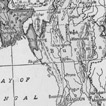North American Pioneer Missionaries Before 1812

This year’s mission bicentennial draws attention to the first North American missionaries who were sent out by an organized mission society. That sending precipitated the sending of hundreds of thousands of North American missionaries who followed after them right up until today. However, it needs to be remembered that there were those who had engaged in cross-cultural and even cross-country missionary work before 1812. Here is a look at some of the better known.
John Eliot
John Eliot (1604 - 1690) was a Puritan missionary to Native Americans. His efforts earned him the designation “the Indian apostle.” Eliot was born in England but emigrated to Boston in 1631 where he became minister and teaching elder at the First Church in Roxbury, founding the Roxbury Latin School in 1645.
Eliot was instrumental in the conversion of the Massachusett Native Americans, whose territory comprised most of what is today the state of Massachusetts, Rhode Island and Connecticut. To help achieve this, Eliot translated the Bible into the native language and published it in 1663. In 1666, his grammar of Massachusett, called “The Indian Grammar Begun,” was published. As a cross-cultural missionary Eliot was best known for putting Native Americans in planned towns in hopes of encouraging them to recreate a Christian society. At one point in time, there were 14 of those so-called “Praying Towns.”
Eliot married Hanna Mumford, and they had six children, five girls and one boy, with only the son surviving. John Eliot died in 1690, aged 85, his last words being “welcome joy!” A monument to him is on the grounds of the Bacon Free Library in Natick, Massachusetts.
David Brainerd
David Brainerd (1718 – 1747) was a missionary to the Native Americans with a particularly fruitful ministry among the Delaware Indians of New Jersey.
Brainerd was born on April 20, 1718 in Haddam, Connecticut, and was orphaned at the age of fourteen. At age 21 he enrolled at Yale but in his second year was sent home because he was suffering from tuberculosis, the disease that would eventually take his life.
In April 1743, Brainerd began work as a missionary at Kaunameek, a Housatonic Indian settlement near present-day Nassau, New York. He remained there for one year, opened a school for Native American children and began to translate the Psalms.
Subsequently, he was reassigned to work among the Delaware Indians along the Delaware River northeast of Bethlehem, Pennsylvania, where he remained for another year. After this, he moved to Crossweeksung, New Jersey, where he had his most fruitful ministry. During these years, he refused several offers to leave missions to become a church minister.
In November 1746, becoming too ill to continue his mission work, he traveled to Northampton, Massachusetts, where he stayed at the house of Jonathan Edwards. He remained with Edwards until his death the following year. He died from tuberculosis on October 9, 1747, at the age of 29.
John Marrant1
John Marrant (1755 – 1791) was one of the first African-American preachers and missionaries. He was born in New York City in 1755. Following the death of his father, he moved with his mother to Georgia and Charleston, South Carolina. At the age of 13 he heard Methodist preacher George Whitefield and was converted. After disagreements with his family about this, he wandered in the wilderness, relying on God to feed and protect him. He was found by a Cherokee hunter and taken to a Cherokee town, where he was sentenced to death. However, his life was spared, allegedly due to the miraculous conversion of the executioner.
Marrant lived with the Cherokees for two years before returning to Charleston, where his own family didn’t recognize him. He continued his missionary work with slaves, despite the objection of their owners, until the start of the American Revolution. By 1775 he had carried the gospel to the Cherokee, Creek, Catawar and Housaw Indians. He was ordained in 1785 and sent to Nova Scotia to minister to several thousand African-Americans who had fled north during the fighting. He then traveled to London in 1790, where he died the following year.
George Liele2
George Liele (1750–1820) was an emancipated African-American slave who became the first missionary to serve outside the borders of the United States and the first Baptist missionary to Jamaica.
Liele was born into slavery in Virginia in 1752, but was taken to Georgia. As an adult he was converted around 1774. Liele was freed by his master, a Baptist and Loyalist, before the American Revolution began. Once freed, Liele went to Savannah, Georgia, where he helped organize an early Baptist congregation.
At the close of the Revolutionary War, Liele chose to depart with the British to ensure his freedom rather than risk re-enslavement in the American South. In 1783 he was transported to Jamaica with his wife Hannah and their four children. He preached at the racecourse in Kingston, where the novelty of a black itinerant ex-slave preacher attracted considerable attention. News of his itinerant-style preaching quickly spread. Lisle (as his name was spelled in Jamaica) was soon able to gather a congregation and purchase a piece of land about a mile from Kingston, where he gradually built a chapel. He formed the First African Baptist Church of Kingston. Over the next 10 years the church grew to over 500. He died in Kingston in 1820.
Prince Williams3
Rev. Prince Williams was the first African-American Baptist missionary to the Bahama Islands. He left Saint Augustine, FL, around 1790 and organized a Baptist church in Nassau. In 1801 he secured land and built a small house of worship, calling it the Bethel Baptist Mission. At age 70 Williams erected St. John’s Baptist Church and ministered there until his death at age 104. Subsequently, 164 Baptist churches were planted in the Bahamas.f









comments